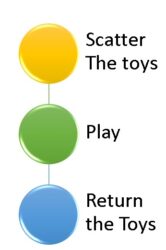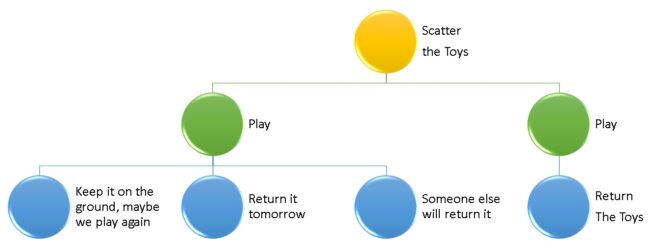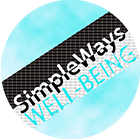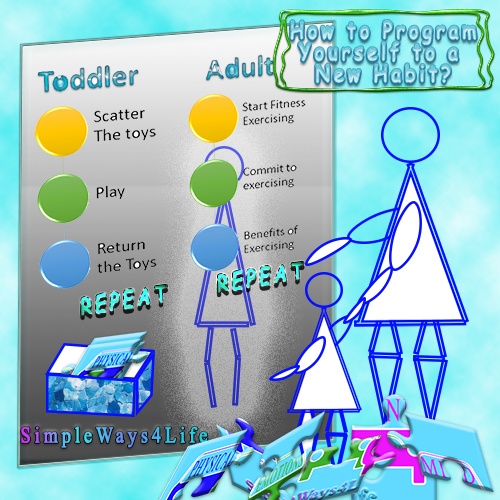We had reached to a conclusion in a previous chat –Learn your own code– that we are a group of programs running together. Some of those programs functions to keep this body alive. Other programs control our interaction to the external environment. Those programs are continuously updated and upgraded or modified to add the new experiences we gain or the new skills we try to learn. Here arises an important question: Are we intentionally programmed or is it a stroke of luck? To be able to answer this question we need to approach gradually: How to program your self?
How can I program a new habit?
You might had came across this question in your life before but in different forms: How can I learn a new skill? How can I add new habits? Is it possible to remove old habits from my life?
All these questions have an implicit meaning of altering our software program by adding new lines of code to it. Computer programs are created in the form of steps to do repeated tasks in the same way every time. Think of any software you are using on your computer or mobile. For example if you are searching for some information on the world wide web, regardless of which browser you are using, you will have these on your results page:
- Number of results: x-million results were found+ Pages of results that match your search
- Did you mean blablabla? + Pages of results that match your search
- There are no results for ——–
- Recommendation for alternative searches
- Categories in which you can find these results, web pages, images, videos, etc.
Every time you do a search you find the same performance from the search engine. We act the same way after we are programmed. We act, react, say, perform in a nearly fixed predicted way every time.
Let us move along the steps of programming a habit in a little child
We shall take a small habit like returning the toys into their box. Usually families start to build this habit in their child at the end of the stage of being a toddler and towards the preschool stage. Programming any habit in the child’s mind needs:
- Example
- Mom or dad is doing it
- Let us do it together
- See this cartoon of a teddy bear doing it
- Let us play a game of arranging our things
- This video game or mobile game – if allowed- is doing this
- Repetition
- Consistency in giving the example and repeating it
- Commitment in doing this every time we spread the toys.
- The one time missed out of order will disrupt the program and add a side bypass with a possibility of not doing this.
- Reward
- Cheering for the good deed
- Hug, kiss or a smile
- Physical reward -may lead to be addicted-
- Maybe a little threatening
- We shall not play again for some time
- Mom or Dad will be sad
- Any other little punishment that don’t disrupt the feeling of safety and security
- Results of the programming effort will end in one of the below charts:
Figure – 1 and Figure – 2:

1- set an Example
2- Consistent – Commitment
3-Habit Implanted, results will follow

1- Set an Example
2- Many Side ways – Probability 25% to do an activity as required
3-Consistency – No Commitment- vice versa or neither
How to program a habit in an adult?
In an adult, the story is a little bit different though the steps are the same.
Let us first see the similar part. Suppose that an adult had intended to start doing some fitness exercises daily. Intention is a very important word that needs a complete chat to discuss about but let it be a good starting point for now. We might start some routines without intention. But, that increases the probability to go side ways and the habit to faint till it disappears..
For the adult to introduce a new habit in his daily life, steps will look something like below:
- He/She will look for an example
- This can come from a website, an app or a fitness club if their time allows it
- They will start gradually to follow, succeeding, failing and getting frustrated as a little child
- Set yourself a reward based on commitment rather than achievement. Commitment leads to achievement
- If you had reached to a well established state of parenting yourself, you might apply a little threatening -also not recommended- in your self talks to keep your commitment to yourself.
- Results will be as figure 1 and figure 2 above.
What is different in adults programming?
The difference is in the distracting effect of the environment over the adult, young adult or even teenagers. For the toddler and preschool stages, the family is all his world. After those stages of life, there are knowledge and experiences stored in the form of sub-programs. They are called automatically in different situations, i.e. programs that run spontaneously based on a stimuli as a reaction. Those programs are not always helping in the direction you want to move in. Some are helping and others are distracting..
Now you know ,
You know how to program a new habit through initiation, startup, commitment, consistency, looking at the benefits and being afraid from the withdrawal drawbacks on you. Repeating the cycle till it is autonomously running is how you program any habit into your life. Same methodology applies in any new activity in your life. Going to a new school, a uni or a job, the first few days are full of emotions and stressors with a lot of ambiguity. After few months, a lot of your daily routines are spontaneous ,and you might start helping others. Where did the frustration and anxiety go? They vanished as this new program was tuned enough and its final version is running automatically without much thinking or feelings.
To live a holistic well-being life, our target should be to program as many helping routines as possible in our life and have enough patience to tune them till we reach a final satisfactory version that bring us benefits: exactly as we had demonstrated with the fitness example. Start small but consistent and committed then grow and benefit. Got 15 minutes? Try hundreds of trainer guided HIIT workouts.
In Conclusion,
Now you now how to program a new habit through initiation, startup, commitment, consistency, looking at the benefits and being afraid from the withdrawal drawbacks on you.
As a grown up now, you have a free will to commit to your track or you may surrender you free will to other subroutines that take you side ways. Let us continue on our next chat.

